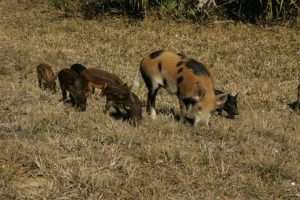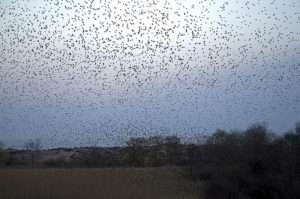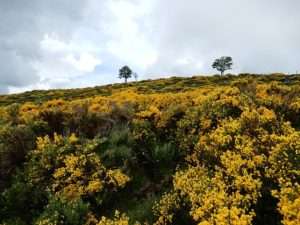 Over the past few centuries, Europeans and their descendants have done all too effective a job at introducing species into ecosystems that they had no previous contact with. Whether that’s European rabbits (Oryctolagus cuniculus) overrunning Australia, feral hogs (Sus domesticus) tearing up North America (and beyond), or domesticated cats (Felis catus) slaughtering entire wildlife species worldwide, many of the species introduced have a widespread negative impact. And lest you think it’s only the animals at fault, invasive plants like butterfly bush (Buddleja davidii), kudzu (Pueraria montana var. lobata), and English ivy (Hedera helix) crowd out native plants and reduce food and shelter for wildlife. Some were introduced on purpose as food or medicine. Others arrived here by accident, unnoticed until it was too late. And then there were those that were put in a place simply because people thought the local flora and fauna weren’t good enough–in other words, acclimatization societies.
Over the past few centuries, Europeans and their descendants have done all too effective a job at introducing species into ecosystems that they had no previous contact with. Whether that’s European rabbits (Oryctolagus cuniculus) overrunning Australia, feral hogs (Sus domesticus) tearing up North America (and beyond), or domesticated cats (Felis catus) slaughtering entire wildlife species worldwide, many of the species introduced have a widespread negative impact. And lest you think it’s only the animals at fault, invasive plants like butterfly bush (Buddleja davidii), kudzu (Pueraria montana var. lobata), and English ivy (Hedera helix) crowd out native plants and reduce food and shelter for wildlife. Some were introduced on purpose as food or medicine. Others arrived here by accident, unnoticed until it was too late. And then there were those that were put in a place simply because people thought the local flora and fauna weren’t good enough–in other words, acclimatization societies.
What Were Acclimatization Societies?
I’m glad I can at least write about acclimatization societies in past tense, because the destruction they wrought through sheer arrogance and ignorance can’t be understated. These groups of Europeans (and Americans and Australians of European descent) popped up during the colonial period of the 19th century, when the British Empire still stretched across wide portions of the planet, and the United States was trying to stretch its borders from sea to shining sea (never mind who was in the way.) Not satisfied with seeing native wildlife in the habitats in which they’d evolved for generations, acclimatization societies enacted a form of colonization involving other species.
They would choose European species that were economically useful in farming, hunting and other activities and scatter them wherever Europeans went. Or they would bring “exotic” species from the Americas, Africa, and other lands and release them into the wilds of Europe. And so forth. It was basically one great big game of mix-and-match for them, with no thought to the consequences.

Their justifications were many. “Well, these animals serve these purposes in their homeland and so we thought they’d be useful here, too!” Or “These are very interesting animals and we’d like people in other places to get to enjoy them out in the wild.” And then there was one particularly egregious act on the part of the American Acclimatization Society’s Eugene Scheiffelin, in which the release of European starlings (Sturnus vulgaris) into New York’s Central Park was part of a goal of having the park host every single bird species William Shakespeare mentioned in his plays. Unluckily for us, the Bard mentioned the starling once, in one play, and that was enough for Scheiffelin.
Acclimatization societies tried to back their actions up with science. The very concept of “acclimatization” is based on the idea that if you slowly introduce members of a species to a place, they’ll eventually integrate themselves into that ecosystem. While there are certainly non-native species that have become naturalized, meaning that they can successfully reproduce in a new area without human intervention, some simply died out without getting a foothold in a new niche. Unfortunately, many of these naturalized species became aggressive invaders, displacing native species, and in some cases even eating them into local, if not total, extinction.
Acclimatization Societies May Be Gone, But Their Legacy Lives On
Thankfully the organized justification of deliberately spreading invasive species in the wild “because we like them!” died out as the 20th century unfolded. Unfortunately, many of the species acclimatization societies treated like living playthings have since gone on to wreak havoc. There are now 200 million European starlings in North America, competing with native birds for nest sites and food. Fallow deer (Dama dama) and axis deer (Axis axis) compete with native tule elk (Cervus canadensis nannodes) and black-tailed deer (Odocoileus hemionus columbianus) for resources on Point Reyes National Seashore (domestic cattle add pressure to the situation as well.) Brushtail possums (Trichosurus spp.) may be native to Australia, but after being brought to nearby New Zealand they’ve been chowing down on the eggs of native birds, damaging native plants, and ruined habitat for native wildlife in general.
Moreover, the practice of deliberately introducing species to new places hasn’t stopped. In a lot of ways, acclimatization societies have been succeeded by the modern widespread trade in exotic plant and animal species. From nurseries and garden stores selling scads of non-native plants, to the exotic pet trade and drive-through “safaris”, the demand for importation and breeding of non-native species is only growing greater. While many of these species may purportedly be bought and sold for captive purposes only, numerous plants and animals have escaped captivity–or been deliberately released. And each species that ends up in the local ecosystem has the chance to wreak havoc if it manages to gain a foothold, especially as climate change continues to ramp up its effects.
 So what can we do about this? The battle against invasive species is a big one, with no simple solutions. But a lot started with educating ourselves and other about the fact that this problem exists, and how we got to this point. This helps us to increase our nature literacy, so that we have a better understanding of how an ecosystem works and what happens when a non-native species is dropped into it. (And it helps us to be more prepared to respond in an informed manner whenever we run into someone who argues that the Scotch broom (Cytisus scoparius) in the Pacific Northwest should be left alone because “it’s pretty”.)
So what can we do about this? The battle against invasive species is a big one, with no simple solutions. But a lot started with educating ourselves and other about the fact that this problem exists, and how we got to this point. This helps us to increase our nature literacy, so that we have a better understanding of how an ecosystem works and what happens when a non-native species is dropped into it. (And it helps us to be more prepared to respond in an informed manner whenever we run into someone who argues that the Scotch broom (Cytisus scoparius) in the Pacific Northwest should be left alone because “it’s pretty”.)
We can also be more selective in what plants and animals we bring into our lives; for example, even if you aren’t going to cultivate a strictly native species-only garden, you can at least avoid the most pernicious invasive species. And if you choose to have exotic animals as pets, be extremely careful to make sure their enclosures are safe and secure; if you must rehome them, make sure they go to a good shelter or rescue, and never release them into the wild to fend for themselves.
